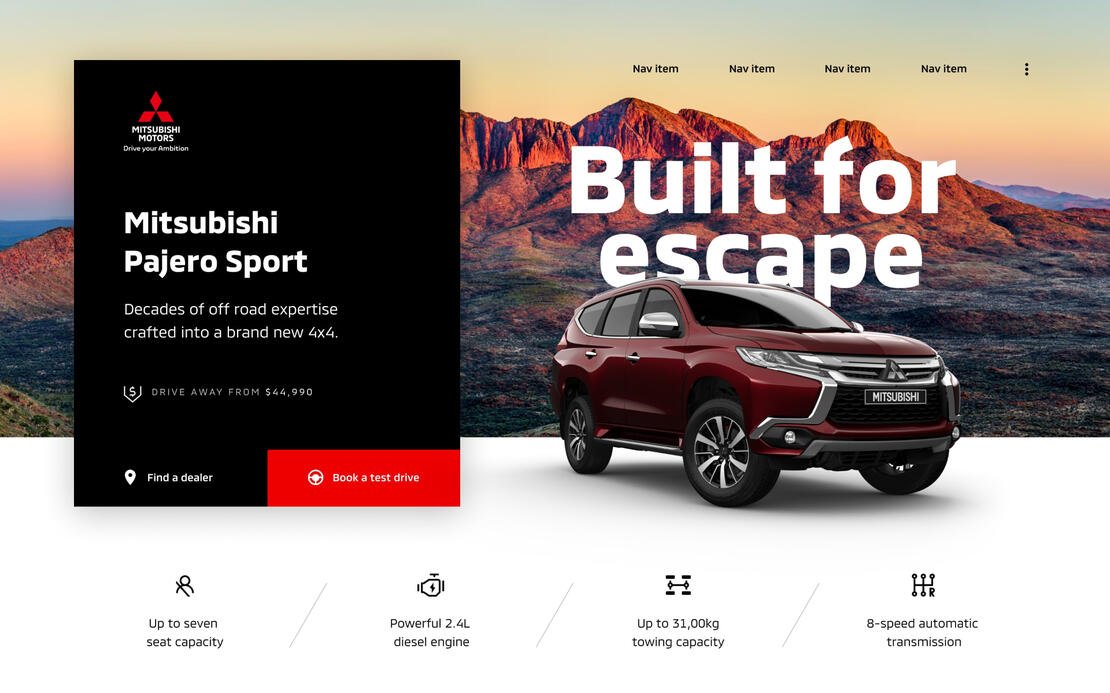
Mitsubishi Motors Project
Mitsubishi commissioned Isobar / Accordant to develop a ground-up rebuild of their public website, working with a third-party supplier developing a new product database for the entire vehicle and accessory range.
My Role
Lead UX Designer
The new Mitsubishi site needed to provide a foundation for a multi-year roadmap of digital marketing and promotion projects for the organisation.
I served as Lead UX Designer from initial Discovery and Research through to the launch of the site, and worked with a Lead UI Designer to develop a design approach that would complement the client’s visual branding, image, and video resources.
DISCOVERY
To understand the needs of the Mitsubishi Marketing and Business teams:
Planned and facilitated a series of workshops to gather information on the goals, measures of success and potential risks of the project,
Conducted stakeholder interviews with heads of marketing, product design, accessories, and fleet sales teams, and
Worked with Magento developers to understand how the vehicle product database was structured and categorised.
To structure the online experience to best suit Mitsubishi's customers:
I reviewed Mitsubishi’s existing customer and market research,
Conducted a series of in-person interviews and a wider online survey with recent new car buyers, and
Undertook a contextual enquiry with dealers at Mitsubishi's Liverpool franchise.
Outcomes
A set of behavioural personas for different types of car buyers.
A customer journey that identified key points that customers were likely to visit the site, and what their expectations and needs would be.
A set of key features and properties of vehicles that different buyers valued.
INSIGHTS
Learnings from this research:
buyers generally visit manufacturer websites very early in their journey, or very late just before purchase.
new car buyers require widely varying levels of detail about a vehicle before committing to buy, from general vehicle aesthetics to detailed technical safety specifications.
these requirements vary greatly even between different buyers of the same vehicle type
after deciding on a shortlist of vehicles, visiting a dealer accelerates making a final purchase.
Outcomes
An approach to content strategy and information hierarchy to give customers enough information to feel confident in contacting a dealer, without overwhelming them with detail.
An approach to module customisation to provide Mitsubishi the flexibility to rapidly update and modify the site to accommodate new vehicles, promotional campaigns, and offers.
A set of preliminary wireframes exploring how pages could be structured using a “toolbox” of modules.
The team developed a modular approach to allow customers to:
find a vehicle they could fall in love with
compare multiple vehicles
find specific vehicle features
build out their ideal vehicle
contact local dealers at any time
These modules were applied to a set of flexible templates that would allow marketing staff to create “showroom” pages highlighting the key features each vehicle including variant pages for different audiences, to prompt user to their best next steps including:
vehicle comparison pages
“Build and Price” functionality or,
contacting a local dealer.
Outcomes
A set of pages designed to lead to more detail for buyers who required it, and easy contact points with dealers for those who were ready to test drive or buy.
APPROACH
IMPLEMENTATION & TESTING
Prototypes of the site were tested in a set of moderated sessions with recent car buyers
The tests focusing on the complex functionality of the “Build and Price” feature of the site to ensure that customers could easily create their ideal vehicle.
User tracking and personalisation functionality were also added to the site to track user behaviour and inform the priorities of future development of the site, as detailed in this Adobe case study on the success of the site.
Mitsubishi Motors Australia works with Isobar to focus on customer-first online experiences.








